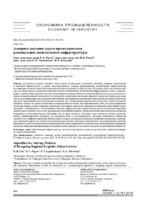| dc.contributor.author | Ивуть, Р. Б. | |
| dc.contributor.author | Попов, П. В. | |
| dc.contributor.author | Лапковская, П. И. | |
| dc.contributor.author | Шевелева, Н. Е. | |
| dc.coverage.spatial | Минск | ru |
| dc.date.accessioned | 2021-07-20T13:31:37Z | |
| dc.date.available | 2021-07-20T13:31:37Z | |
| dc.date.issued | 2021 | |
| dc.identifier.citation | Алгоритм решения задачи проектирования региональной логистической инфраструктуры = Algorithm for Solving Problem of Designing Regional Logistics Infrastructure / Р. Б. Ивуть [и др.] // Наука и техника. – 2021. – № 4. – С. 352-356. | ru |
| dc.identifier.uri | https://rep.bntu.by/handle/data/97719 | |
| dc.description.abstract | Рассмотрен алгоритм решения задачи поиска оптимальной дислокации ключевых объектов транспортной и складской инфраструктур в рамках методологического подхода проектирования логистической инфраструктуры на территории регионов стран. Методологический подход включает в себя три этапа. На первом этапе определяются районы, где целесообразно размещение ключевых объектов региональной логистической инфраструктуры. Далее с использованием разработанных авторами моделей, осуществляется привязка объектов складской инфраструктуры на местности и с учетом спроектированной складской сети определяется оптимальная дислокация объектов транспортной инфраструктуры. Для поиска оптимальных мест расположения объектов региональной логистической инфраструктуры авторы предлагают алгоритм, применимый для построения как складской, так и транспортной инфраструктур вследствие схожести моделей. Алгоритм основан на методе построения последовательности планов. На первоначальном этапе для рассматриваемого множества планов строится конечное расширение. Для данного множества определяется миноранта для функции затрат, связанных с размещением и обслуживанием объектов инфраструктуры, перемещением грузов и перегоном порожнего транспортного средства. После этого формируется итеративный алгоритм, определяющий последовательность оптимумов миноранты на последовательности вложенных друг в друга множеств. На первом шаге находится элемент множества планов, минимизирующий миноранту, на следующем шаге из рассматриваемого множества исключается найденный элемент и на оставшемся множестве ищется новый оптимум, для которого миноранта принимает минимальное значение. Для элиминации множества планов целесообразно использовать процедуры динамического программирования. Границы применимости метода построения последовательности планов определяются возможностью сконструировать расширение множества планов размещения объектов, подобрать на нем миноранту и построить алгоритм упорядочивания оптимумов. | ru |
| dc.language.iso | ru | ru |
| dc.publisher | БНТУ | ru |
| dc.title | Алгоритм решения задачи проектирования региональной логистической инфраструктуры | ru |
| dc.title.alternative | Algorithm for Solving Problem of Designing Regional Logistics Infrastructure | ru |
| dc.type | Article | ru |
| dc.identifier.doi | 10.21122/2227-1031-2021-20-4-352-356 | |
| local.description.annotation | The paper considers an algorithm for solving the problem of finding the optimal location of key objects of transport and warehouse infrastructures within the framework of a methodological approach to designing logistics infrastructure in the territory of the region of the countries. The methodological approach includes three stages. At the first stage, areas are determined where it is advisable to locate key objects of the regional logistics infrastructure. Further, using the models developed by the authors, the linking of warehouse infrastructure objects on the ground has been carried out and, taking into account the designed warehouse network, the optimal dislocation of transport infrastructure objects has been determined. To find the optimal locations for the objects for regional logistics infrastructure facilities, the authors propose an algorithm that is applicable both for building warehouse and transport infrastructures due to the similarity of the models. The algorithm is based on the method of constructing a sequence of plans. At the initial stage, the final expansion is constructed for the set of plans under consideration. For a given set, a minorant has been determined for the cost function associated with the placement and maintenance of infrastructure facilities, the movement of goods, and the haul of an empty vehicle. After that, an iterative algorithm has been formed that determines the sequence of optima of the minorant on a sequence of nested sets. At the first step, an element of the set of plans has been found that minimizes the minorant, at the next step, the found element is excluded from the set under consideration, and a new optimum is sought on the remaining set for which the minorant takes the minimum value. To eliminate multiple plans, it is advisable to use dynamic programming procedures. The limits of applicability of the method for constructing a sequence of plans are determined by the ability to construct an extension of the set of plans for placing objects, select a minorant on it, and build an algorithm for ordering optima. | ru |

